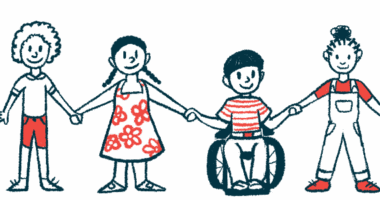Sharing Our Stories With the SMA Community’s Next Generation


Many years ago, I was sitting in Disney World’s Magic Kingdom waiting for the start of a parade. A few feet away, a boy with a disability also was waiting. He was resting in a flat stroller that allowed him to lie down, and a BiPap machine helped him breathe. He looked like he had SMA.
My mom didn’t hesitate to introduce everyone and start a conversation. The boy’s name was Jacob, and as it turns out, we did have the same disease.
Disney World often welcomes attendees of the annual Cure SMA conferences, and when it does, you’re likely to bump into hundreds of fellow SMA families inside the park. But this particular family trip didn’t actually include a conference, so meeting another family was unexpected. In a sea of people, our families had been drawn together when we recognized something familiar — something we shared. As a result of that encounter, our families exchanged contact information, and we remained friends with Jacob until he passed away a few years later.
Today, I’m not sure if I would recognize a kid with SMA in a crowd, because the disease doesn’t always look like it used to. Current treatments have proven to be highly effective in infants and children, so even kids with the most severe type don’t always show obvious signs of the disease to passersby who aren’t looking closely. Even my trained eye struggles to see it sometimes.
The face of SMA is changing, and our community’s culture is changing with it. I sometimes wonder how the lessened effects of SMA will shape this new generation that is growing up in an environment that’s so different from the one my generation grew up in.
My heart leaps with joy at the sight of children with SMA who are reaching milestones that were unfathomable to my friends and me when we were kids. These kids might not have to undergo as many surgeries or spend as much time hospitalized as we did. They might not need to rely on medical equipment to breathe, eat, talk, and walk for them. And that’s incredible.
But while those experiences sometimes resulted in hardship and heartbreak for us, they gave us some valuable things, too. Living with SMA helped teach and enforce empathy, resilience, gratitude, community, creativity, humility, spirituality, patience, and maturity, and these qualities are key components of the adults we became. I don’t want future generations to endure the challenges we’ve faced, but I wonder what will foster these traits in them if not SMA?
Facing this dilemma, I’ve actually turned to learning about Holocaust survivors for insight. I won’t pretend for a second that the tragedies they faced are comparable to what I experience with a disability. The Holocaust was one of the most devastating events in world history, and it should always be treated as such.
But the stories these survivors have told, and the manner in which society has responded to them, offer possible answers to my wonderings. Generation after generation has gathered around them to hear what they have to teach us. While most of us haven’t lived through anything like it, their experiences influence the way we choose to live. By word of mouth, they impart onto us the lessons and traits that have resulted from what they’ve been through.
So, if Holocaust survivors can pass on the pieces of their lives that they want us to remember, maybe the SMA community can do the same. Maybe that’s one of the reasons why so many of us have become writers, speakers, or social media influencers. We know that words and stories have power, and we believe that we can use them to help shape the world and future in a positive way.
I don’t know exactly what the future of my beloved community looks like, but change is inevitable. And that’s not bad. Treatments will continue advancing, and a cure could be just over the horizon. SMA might one day become a whisper from the past, and I’m waiting in anticipation of that day.
I believe with my whole heart that the future is bright. I pray that the stories we tell are enough to preserve the qualities and memories that are worth keeping for the generations to come. I hope they take the torch of the legacy our community has built, and I hope they run with it — literally.
***
Note: SMA News Today is strictly a news and information website about the disease. It does not provide medical advice, diagnosis, or treatment. This content is not intended to be a substitute for professional medical advice, diagnosis, or treatment. Always seek the advice of your physician or other qualified health provider with any questions you may have regarding a medical condition. Never disregard professional medical advice or delay in seeking it because of something you have read on this website. The opinions expressed in this column are not those of SMA News Today, or its parent company, BioNews, and are intended to spark discussion about issues pertaining to spinal muscular atrophy.
The post Sharing Our Stories With the SMA Community’s Next Generation appeared first on SMA News Today.




